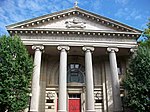Information Networking Institute
The Information Networking Institute (INI) was established by Carnegie Mellon in 1989 as the nation's first research and education center devoted to information networking.As an integral department of the College of Engineering and a collaboration of the School of Computer Science, the Tepper School of Business, and the Heinz College, the INI's professional graduate degree programs represent a fusion of technologies, economics and policies of secure communication networks, systems and services. The INI also partners with research and outreach entities to extend educational and training programs to the broad audience of people using information networking as part of their daily lives. The INI is the educational partner of Carnegie Mellon CyLab, a university-wide, multidisciplinary research center involving more than 50 faculty and 100 graduate students.
Excerpt from the Wikipedia article Information Networking Institute (License: CC BY-SA 3.0, Authors).Information Networking Institute
South Dithridge Street, Pittsburgh
Geographical coordinates (GPS) Address Nearby Places Show on map
Geographical coordinates (GPS)
| Latitude | Longitude |
|---|---|
| N 40.44608 ° | E -79.94805 ° |
Address
Carnegie Mellon University
South Dithridge Street
15213 Pittsburgh
Pennsylvania, United States
Open on Google Maps









